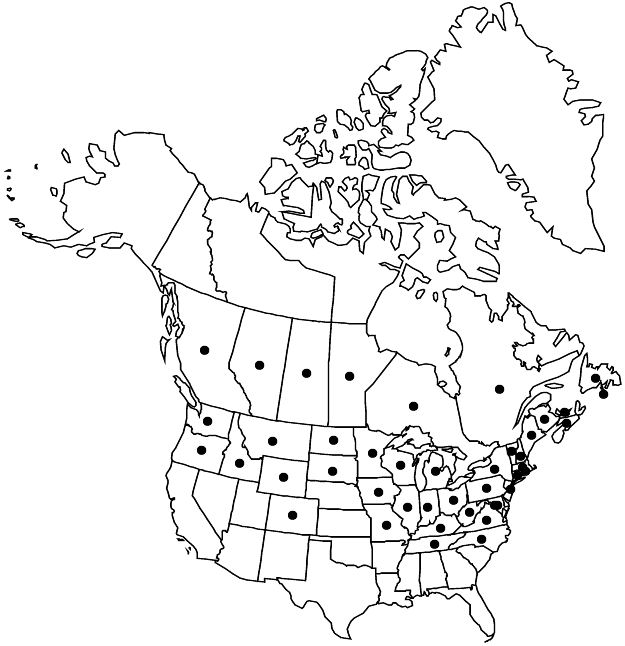Potentilla argentea
Sp. Pl. 1: 497. 1753.
Stems mostly decumbent to ascending, 1–6 dm. Basal leaves palmate. Cauline leaves 2–9, proximal ones 2–7(–10) cm; proximal petioles 1–4(–7) cm, long hairs absent or sparse, ± ascending, 1–2 mm, soft, short and crisped hairs absent or obscured, cottony hairs dense, glands absent or obscured; leaflets 5(–7), central one ± oblanceolate, (0.5–)1–3 × 0.3–1(–1.3) cm, margins revolute, distal 1/2–2/3 evenly or unevenly incised 1/2–3/4+ to midvein, teeth 2–3 per side (more if lobed or secondarily toothed), surfaces strongly dissimilar, abaxial white, long hairs ± sparse (mostly on veins), 1–2 mm, weak, short and crisped hairs absent or obscured, cottony hairs dense, glands absent or obscured, adaxial long hairs absent or sparse to common, short or crisped hairs absent or sparse, cottony hairs absent, glands absent or sparse. Inflorescences 10–80-flowered. Pedicels 0.3–1.5(–2) cm. Flowers: epicalyx bractlets oblong to narrowly ovate, 1.5–3 × 0.7–1.2 mm, lengths 2/3–1 times sepals; sepals 2–4.5 mm, apex ± acute; petals (2–)2.5–4 × 1.5–3 mm; filaments 0.8–1.5 mm, anthers 0.3–0.6(–0.8) mm; carpels 30–60, styles 0.6–0.9 mm, often strongly papillate-swollen proximally. Achenes 0.8–1.1 mm, smooth to lightly rugose. 2n = 14, 28, 35, 42, 56, 62 (Eurasia).
Phenology: Flowering spring–summer.
Habitat: Dry flats and slopes, roadsides, dry ditches, other open sites, in grasslands, oak and conifer woodlands
Elevation: 0–2000 m
Distribution

Introduced; St. Pierre and Miquelon, Alta., B.C., Man., N.B., Nfld. and Labr. (Nfld.), N.S., Ont., P.E.I., Que., Sask., Colo., Conn., D.C., Idaho, Ill., Ind., Iowa, Ky., Maine, Md., Mass., Mich., Minn., Mo., Mont., N.H., N.J., N.Y., N.C., N.Dak., Ohio, Oreg., Pa., R.I., S.Dak., Tenn., Vt., Va., Wash., W.Va., Wis., Wyo., Eurasia, introduced also in Pacific Islands (New Zealand).
Discussion
The bright, silvery vestiture of the leaves quickly distinguishes Potentilla argentea from P. inclinata and P. intermedia. Although treated here as introduced, some (P. A. Rydberg 1898; P. A. Werner and J. D. Soule 1976) considered P. argentea to be probably native in eastern North America.
The Potentilla argentea species group is an amphi- or apomictic polyploid complex that has been the subject of numerous cytological, sexual, and molecular studies (for example, A. Müntzing and G. Müntzing 1945; A. Müntzing 1958; J. Paule et al. 2011). Taxonomic treatments have ranged from a highly polymorphic single species to an abundance of species, varieties, and forms (T. Wolf 1908). This treatment is at the conservative end of the spectrum. Some New England references (R. C. Bean et al. 1967; F. C. Seymour 1969) distinguish plants with densely white-hairy adaxial leaflet surfaces as var. pseudocalabra Th. Wolf, a name based on plants from southeastern Europe. Molecular analysis by Paule et al. supports the conclusion by Wolf that the variety consists of intermediates between P. argentea and P. calabra Tenore. The optimum taxonomic disposition of var. pseudocalabra, and whether any North American plants are properly included, remains to be determined.
Potentilla argentea has been reported as an active agent in treating cirrhosis of the liver (N. T. Starostenko and V. N. Starostenko 1971).
Selected References
None.